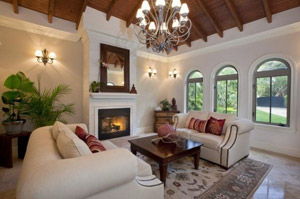Activation of the "Ba Gua" areas - is very useful something to do, but we must also take into account the general rules of Feng Shui in arranging house and interior design.
Otherwise it may happen, that all your efforts in a particular sector will go down the drain. Feng Shui likes, when everything is harmonious in your home, and even the simple implementation of the recommendations below will be able change your life for better.
Whe n you are creating a proper Feng Shui design for your home, you have to keep the optimum balance of "Yin" and "Yang". To achieve this, there have to be present all five elements: Fire, Metal, Water, Earth and Wood. You have to activate your own element correctly and carefully.
n you are creating a proper Feng Shui design for your home, you have to keep the optimum balance of "Yin" and "Yang". To achieve this, there have to be present all five elements: Fire, Metal, Water, Earth and Wood. You have to activate your own element correctly and carefully.
Placing pieces of furniture and choosing the finishing materials, do not forget about the cycles of creation and destruction. You are afraid, it will be difficult? Not at all. All materials are divided into natural and synthetic ones. According to the Feng Shui, such materials as polymers, plastics, synthetics are the result of scientific and technological progress, and therefore they belong to the "Yang" energy. In order not to overreact with this kind of energies, we must take this into the account.
The purpose of every given room should not be ignored. If it is an office or a workshop, the objects there may have more "Yang" energy, because it is active, masculine element. In the bedroom and living room, on the contrary, house dwellers will feel better in the presence of the objects with well pronounced properties of "Yin". Here different rugs and sofas - especially those with the velvet upholstery - will do very well.
Flooring is better to choose from the natural materials, parquet would be the best option here. All wooden objects have a very nice feature: they are suitable for the representatives of all elements, except for the people of Earth, because the excess of wooden objects will give here a depressing impact. Parquet is better to be fixed as a herringbone, the angles must be sent from the front door towards the internal space. This will determine the movement of a beneficial Qi energy. Panelboard parquet is better to buy square or an octagon shaped.
Now about the ceiling. It would be better if your ceiling is not higher than four and not less than two and a half meters. If the ceiling is very high, you can make a loft, it is original and useful, also there will be more free space left in the house and the movement of a negative energy will be smoothed out. Some people are painting the ceiling in dark colors to make it visibly lower. We do not advise you to do it, because too dark ceiling is creating a threat and the "Qi" energy does not like dark colors. You can paint over the ceiling some small prints, this way the height will be visually reduced. If the ceiling is low, you should not increase it with mirrors. This disrupts the harmony of the five elements and the smooth movement of "Qi" will not be possible. Also it is not good to paint the ceiling in blue (this is especially true for the suspended ceilings). Thus, you are putting water over your head, but it's wrong and can be dangerous for you.
The interior of your home should be thoroughly thought out. In those places where you spend a lot of time - sleeping, reading, hanging out, watching TV - there should not be any chances to attract the negative "Sha" energy. So do not hang shelves at these locations and do not put tables, coffee tables and other furnishings in any available places. Avoid symmetry in the arrangement of your furniture and accessories.
All items that have some ledges up are emitting a positive energy, and those, having projections downward - negative. If you live all the time beside the objects that emit negative energy, it may unbalance your body. For example, a chandelier with horns upwards has positive energy, a table - negative, because it's legs are going down. You need to seek balance in everything, then your home will always be safe and comfortable for all family members.